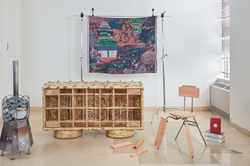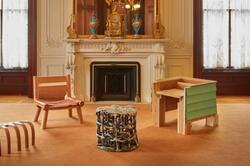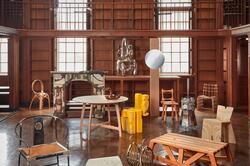Grounding Space
WANTED at ICFF 2025
MAY 18 - 20, NEW YORK, NY

Remixing stylistic traditions and historical ornament and embracing the fantastical, this exhibition explores dimensionality—in virtual and physical realms—with natural and synthetic materials and through both traditional and exploratory functional objects. As our experience of space becomes more expansive, we remain inextricably tethered to the Earth. The work highlights curiosity and imagination as modes of exchange and understanding, all the while navigating diverse contextual realities. Grounding Space expands upon traditional furniture archetypes and alludes to atmospheric forces, poetically wielding light and employing materials made possible by advances in industry. It invites us to consider the act of creation as an opportunity for irreverence, homage and complexity. From 1800s farm equipment to the powerful cultural symbolism of animals and the creative possibilities of circuit boards, the work in this exhibition is an amalgam of time and space—a collective composition—that grounds us in the now.
Directed by faculty members Pete Oyler, Jonah Takagi, Amy Devers
Graphic Design by Casey Callahan
Photography by Jonah Takagi
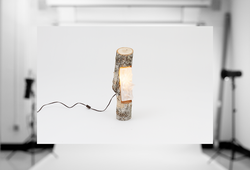
It’s What’s Inside (Log Light) No.1
Kailyn Bryant, BFA 25 FD
Beech log, PETG filament, lighting components
18 x 5 x 5"
It’s What’s Inside explores the interplay between natural material and synthetic intervention, questioning the boundaries between organic and artificial presence. A beech log—once a solid, impenetrable form—is partially hollowed out, its interior replaced with a glowing synthetic structure. The PETG filament acts as both a membrane and a threshold, diffusing the internal light while revealing the human intervention that transformed the log’s interior. The warmth emanating from within suggests a life force, yet it is one generated by artificial means, challenging perceptions of what is natural and what is constructed.
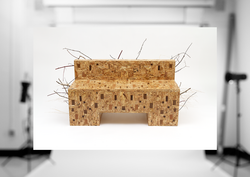
Oriented Structures of Being (O.S.B No. 1) Bench
Kailyn Bryant, BFA 25 FD
Oriented strand board, white oak, knotty alder, maple, ash, red oak, red-osier dogwood, foraged sticks from Providence, RI, and the Massachusetts Berkshires
39 x 72 x 32"
This bench examines the relationship between unprocessed natural elements—tree branches, grass and hardwood—and highly industrial materials like oriented strand board (OSB). Titled O.S.B No. 1, the piece is guided by a system of probability and chance. Fragments of OSB and hardwood merge seamlessly at their joints through precise nailing and sanding. Despite their contrasting levels of processing, these materials come together to form a unified structure, demonstrating a shared language.

Weekday Wardrobe
Nino Chambers, MFA 25 FD
White oak, cotton organdy, cotton shirt
42 x 25 x 9"
Weekday Wardrobe offers a counterpoint to disposability. Designed to hold just five cotton shirts, the piece aims to reframe our understanding of the resources and space we dedicate to our clothing, while also encouraging maintenance and repair. Translucent cotton fabric graces the exterior of the wardrobe, offering a veiled glimpse of its interior contents and blurring the boundary between object and enclosure.
The piece reflects Nino’s ongoing inquiry into how design shapes and responds to patterns of consumption.
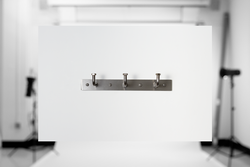
Bent Bolt Wall Hooks
Andrew Goulet, MFA 26 FD
Stainless steel
2 x 36 x 2"
The hooks were inspired by a lag screw that had been bent after being repeatedly run over in the crosswalk at 49th Avenue and 21st Street in Queens, NY.
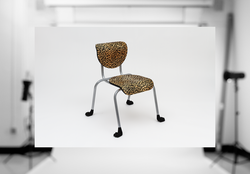
National Geographic
Jack Kemper, BFA 25 FD
Steel, plywood, polyurethane, polypropylene, vinyl, flocking
35 x 19 x 20"
National Geographic is about post-colonial public relations. The lion is a mirage, a miracle cited like an image of Jesus on a pancake. Animals’ feet have been an integral part of expressive making since the Neolithic era, taking on a constant flurry of new meanings as their contexts shift. The lion’s foot entered the world of design as a symbol of colonial power in Europe, abstracting and flattening the lion into a simulation of itself, much like the maps of the empire. The rugs, skins and prints of the cheetah do much the same. “Today abstraction is no longer that of the map” (Baudrillard). Today abstraction is a complete irreverence for material origin and history, a collage of conflicting realities that renders material, form and production completely alienated from each other. National Geographic is the tragic comedy that these overlapping vignettes produce. It is just another punchline hot off the press in the morning; it is chaos embodied.
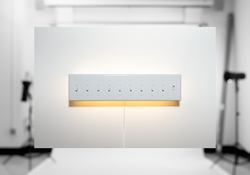
Turn on Light
Xubai Li, MFA 25 FD
Toggle switches, standard switch plates, acrylic
5 x 19 x 5''
Turn on Light consists of a front-facing switch panel and an unconventional number of toggle switches that match the standard American toggle switch system. It offers 10 controls, and users can turn it on/off by a toggle action. This design proposes a unique, self-referred object—the focus shifts from the usual main character, the light, back to the switch.
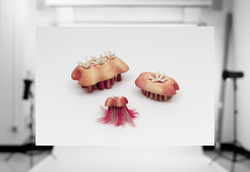
Critters
Maggie McCreery, BFA 26 FD & Riley Borst, BFA 25 TX
Basswood, broomcorn, tampico fiber, cochineal, mulberry extract, pine tar, wool
7 x 12 x 18'', 6 x 8 x 13'', 6 x 4 x 6''
McCreery and Borst were inspired to create furniture objects that facilitate relationship and autonomy for the unspeaking. Mimicking human relationships, the goal of the Critters is to change and be changed through interaction. Critters refuse self sacrifice despite their silent disposition, equally able to be sat upon and to crawl out from under you.
The project stems from an exploration of how textiles and furniture might intersect, specifically through their material composites. The makers were excited to uncover how woody, structural fibers could be translated to textile, finding that tampico, broomcorn and cochineal could be that thread between.
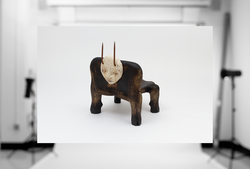
Bull
Gretsy Moreno Ortiz, BFA 25 FD
Wood, steel, acrylic
32 x 22 x 21''
To sit with the contradictions, to contemplate the complexity and vulnerability of human existence, to meditate, to question…

Enzo Chair
August Ostrow, BFA 25 FD
Birch, maple veneer, galvanized steel pipe, hardware
32 x 22 x 20''
Enzo Chair is a reinterpretation of Enzo Mari’s Box Chair, translated into the medium of bent lamination. This project builds on research into Mari’s design philosophy, particularly his attention to fasteners seen in the Autoprogettazione? collection. Ostrow considered how Mari might adapt his methods today, given the expanded availability of hardware and household tools. Unlike the limited fasteners and hand tools accessible in the 1970s, contemporary makers have access to a vast array of hardware, enabling new construction possibilities while maintaining the spirit of accessible, self-made design. Bent lamination’s unique structural properties allow for a connection system that integrates contemporary hardware in a way that enhances both strength and ease of assembly.
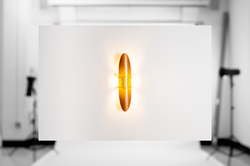
PC Sconce
August Ostrow, BFA 25 FD
Custom polyimide PCB, machined aluminum, ASA plastic, electronics
12 x 4 x 4''
PC Sconce is an exploration of the functional and formal possibilities of flexible polyimide circuit boards. With this technology, Ostrow is able to create a lamp shade with the light source integrated into it. To maintain transparency in how the lamp functions, the supporting armature not only holds the polyimide shade but also serves as the electrical connection to the DC power supply, merging structure and circuitry into a single, cohesive system.

Spore Chair
David Schwimmer, BFA 25 FD
PLA
26 x 26 x 30"
The novelty of the chair is that Schwimmer commandeers a video game about creating animals and creatures to make an object that can be recognizable as a chair, and the challenge/ benefit is that all the parts available are parts of animals not meant to create chairs. The actual part of the game used is called the creature creator, and so making an animal and making a chair become one and the same thing. This specific chair was meant to be a comedic take on what the ancestor to Windsor chairs might look like given the parts available. Including the head makes it more recognizable as a product of the specific spore process.
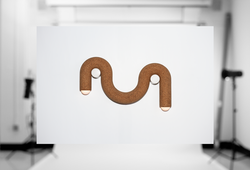
Hang Sconces
Sam Sherman, MFA 25 FD
Recycled cork granulate
12 x 20 x 4"
Hang Sconces are a series of playful, sculptural wall lights made from recycled cork granulate. They are part of Sherman’s Granulate Collection, a larger body of work that explores the potential of waste materials from subtractive manufacturing to create high-quality furniture and lighting. This collection challenges the perception of these by-products as limited in use, showcasing their ability to support complex, efficient manufacturing while producing beautiful, functional objects. Hang Sconces further push these manufacturing possibilities by incorporating advanced techniques usually seen as exclusive to plastic or rubber such as hollow casting, overmolding and intricate geometries.
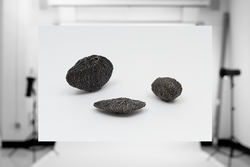
Vessels
Emelia Violich, BFA 25 FD
Steel
2 x 4 x 7", 4 x 3 x 5", 6 x 3 x 8"
Steel vessels, created by repetitive welding.

Tractor Stool
Oscar Walsh, BFA 25 FD
Beech, polyurethane, yellow stain
27 x 17 x 15"
Ushered by a respect for the design and problem solving buried in 1800s tractor seats, this stool by Oscar Walsh, finished with a vibrant yellow stain, merges traditional craftsmanship with a modern aesthetic. Its three turned legs and stretchers provide sturdy elegance, while the tractor-style seat offers comfort through thoughtful shaping. The result of removing and leaving material only where needed is a considered design that is shockingly lightweight.
Connect with RISD FD
For press inquiries, please contact:
Jaime Marland
RISD Public Relations
401 427-6954
jmarland@risd.edu
For information on specific works, please contact:
Stephanie Darling
Furniture Design Department, RISD
sdarling@risd.edu
